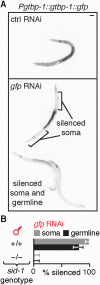Extracellular RNA is transported from one generation to the next in Caenorhabditis elegans
- PMID: 27791108
- PMCID: PMC5098612
- DOI: 10.1073/pnas.1608959113
Extracellular RNA is transported from one generation to the next in Caenorhabditis elegans
Abstract
Experiences during the lifetime of an animal have been proposed to have consequences for subsequent generations. Although it is unclear how such intergenerational transfer of information occurs, RNAs found extracellularly in animals are candidate molecules that can transfer gene-specific regulatory information from one generation to the next because they can enter cells and regulate gene expression. In support of this idea, when double-stranded RNA (dsRNA) is introduced into some animals, the dsRNA can silence genes of matching sequence and the silencing can persist in progeny. Such persistent gene silencing is thought to result from sequence-specific interaction of the RNA within parents to generate chromatin modifications, DNA methylation, and/or secondary RNAs, which are then inherited by progeny. Here, we show that dsRNA can be directly transferred between generations in the worm Caenorhabditis elegans Intergenerational transfer of dsRNA occurs even in animals that lack any DNA of matching sequence, and dsRNA that reaches progeny can spread between cells to cause gene silencing. Surprisingly, extracellular dsRNA can also reach progeny without entry into the cytosol, presumably within intracellular vesicles. Fluorescently labeled dsRNA is imported from extracellular space into oocytes along with yolk and accumulates in punctate structures within embryos. Subsequent entry into the cytosol of early embryos causes gene silencing in progeny. These results demonstrate the transport of extracellular RNA from one generation to the next to regulate gene expression in an animal and thus suggest a mechanism for the transmission of experience-dependent effects between generations.
Keywords: circulating RNA; endocytosis; epigenetics; parental RNAi; transgenerational inheritance.
Conflict of interest statement
The authors declare no conflict of interest.
Figures
















Similar articles
-
Double-stranded RNA made in C. elegans neurons can enter the germline and cause transgenerational gene silencing.Proc Natl Acad Sci U S A. 2015 Feb 17;112(7):2133-8. doi: 10.1073/pnas.1423333112. Epub 2015 Feb 2. Proc Natl Acad Sci U S A. 2015. PMID: 25646479 Free PMC article.
-
SID-1 Domains Important for dsRNA Import in Caenorhabditis elegans.G3 (Bethesda). 2017 Dec 4;7(12):3887-3899. doi: 10.1534/g3.117.300308. G3 (Bethesda). 2017. PMID: 29025917 Free PMC article.
-
SID-1 Functions in Multiple Roles To Support Parental RNAi in Caenorhabditis elegans.Genetics. 2017 Oct;207(2):547-557. doi: 10.1534/genetics.117.300067. Epub 2017 Jul 27. Genetics. 2017. PMID: 28751423 Free PMC article.
-
Construction of plasmids for RNA interference and in vitro transcription of double-stranded RNA.Methods Mol Biol. 2006;351:109-17. doi: 10.1385/1-59745-151-7:109. Methods Mol Biol. 2006. PMID: 16988429 Review.
-
Expanded CUG Repeats Trigger Disease Phenotype and Expression Changes through the RNAi Machinery in C. elegans.J Mol Biol. 2019 Apr 19;431(9):1711-1728. doi: 10.1016/j.jmb.2019.03.003. Epub 2019 Mar 14. J Mol Biol. 2019. PMID: 30878478 Review.
Cited by
-
Small RNAs and chromatin in the multigenerational epigenetic landscape of Caenorhabditis elegans.Philos Trans R Soc Lond B Biol Sci. 2021 Jun 7;376(1826):20200112. doi: 10.1098/rstb.2020.0112. Epub 2021 Apr 19. Philos Trans R Soc Lond B Biol Sci. 2021. PMID: 33866817 Free PMC article. Review.
-
TRIM-NHL protein, NHL-2, modulates cell fate choices in the C. elegans germ line.Dev Biol. 2022 Nov;491:43-55. doi: 10.1016/j.ydbio.2022.08.010. Epub 2022 Sep 3. Dev Biol. 2022. PMID: 36063869 Free PMC article.
-
Hypoxia induces transgenerational epigenetic inheritance of small RNAs.Cell Rep. 2022 Dec 13;41(11):111800. doi: 10.1016/j.celrep.2022.111800. Cell Rep. 2022. PMID: 36516753 Free PMC article.
-
Embryo integrity regulates maternal proteostasis and stress resilience.Genes Dev. 2020 May 1;34(9-10):678-687. doi: 10.1101/gad.335422.119. Epub 2020 Mar 26. Genes Dev. 2020. PMID: 32217667 Free PMC article.
-
Legacies of salient environmental experiences-insights from chemosensation.Chem Senses. 2024 Jan 1;49:bjae002. doi: 10.1093/chemse/bjae002. Chem Senses. 2024. PMID: 38219073 Free PMC article.
References
-
- Pembrey ME, et al. ALSPAC Study Team Sex-specific, male-line transgenerational responses in humans. Eur J Hum Genet. 2006;14(2):159–166. - PubMed
Publication types
MeSH terms
Substances
Grants and funding
LinkOut - more resources
Full Text Sources
Other Literature Sources

